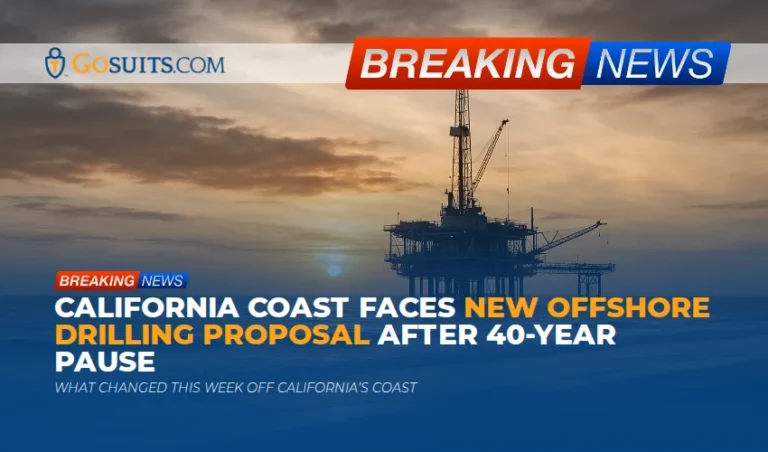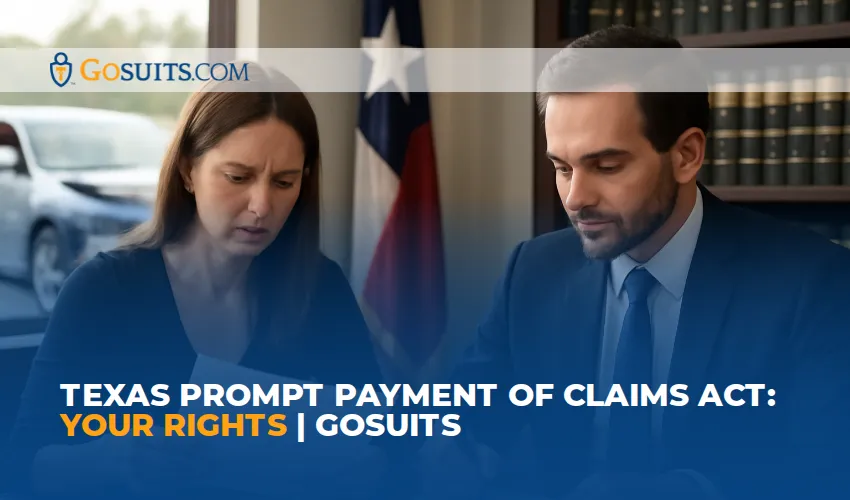- What changed this week off California’s coast
- What offshore drilling could mean for coastal communities and workers
- A brief history of offshore oil incidents near Southern California
- Who investigates and what records to request
- Rights and options after injuries, exposures, or losses
- Insurance and claims considerations
- Steps to take in the first 72 hours after a spill or platform accident
- Local resources and contacts
- Legal timelines and key deadlines in California
- How liability may be evaluated in offshore incidents
- Commentary from Gosuits California Personal Injury Attorney
- Why acting promptly matters now
What changed this week off California’s coast
Reports indicate a federal proposal is being prepared to open areas off California’s coastline to new offshore oil and gas leasing for the first time in roughly four decades. The Department of the Interior could release details soon, setting up a policy clash with state leaders who have long opposed new offshore drilling. While analysts suggest industry interest may be limited, even a proposal can trigger planning steps, public comment periods, and legal challenges that affect coastal communities, workers, and small businesses from San Diego to the North Coast.
Why does this matter locally? In Southern California, offshore platforms and pipelines intersect with daily life in places like Huntington Beach, Seal Beach, Long Beach, the Port of Hueneme, the Port of Los Angeles, and the Santa Barbara Channel. Surf lineups at Bolsa Chica, fishing out of Dana Point and Ventura Harbor, sunset walks along the Manhattan Beach Strand, and whale-watching boats out of Newport all share a coastline where offshore energy infrastructure and shipping lanes already exist in federal waters. When policy shifts, risks and responsibilities can shift with them.
What offshore drilling could mean for coastal communities and workers
Offshore development is governed by federal and state laws aimed at balancing energy production with public safety and environmental protection. In practice, accidents can still happen. Impacts tend to fall into three buckets: worker safety, environmental contamination, and economic disruption for coastal communities.
Worker safety and maritime injuries
Platform crews, supply boat teams, divers, and contractors face unique hazards: heavy equipment, confined spaces, helicopter transport, and offshore weather. When incidents occur, injured offshore workers may have different legal remedies than land-based employees, including claims under the Jones Act and related maritime doctrines that account for vessel conditions, employer negligence, and seaworthiness. See the federal Jones Act statute at 46 U.S.C. § 30104 (Cornell LII).
Environmental contamination and shoreline closures
Oil spills can trigger beach and harbor closures, no-swim advisories, and fishery disruptions. California’s Office of Spill Prevention and Response (OSPR) has documented impacts from past events, including the 2021 Orange County pipeline leak that fouled waters near Huntington Beach, Newport Beach, and Laguna Beach and led to closures and wildlife rescue measures. See OSPR’s incident page for the 2021 pipeline release in Orange County at the California Department of Fish and Wildlife’s site: OSPR.
Economic disruption for local businesses and workers
Oil on the water has a way of rippling through communities: charter boats cancel, surf schools pause, coastal restaurants see fewer customers, lifeguard towers sit empty, and small shops lose foot traffic. Under the federal Oil Pollution Act of 1990, certain economic losses linked to a spill may be compensable, including loss of profits and impairment of earning capacity. The Environmental Protection Agency explains OPA’s damages categories here: EPA: Oil Pollution Act summary.
A brief history of offshore oil incidents near Southern California
Californians carry a long memory of offshore spills. The 1969 Santa Barbara Channel blowout released millions of gallons of crude, galvanized modern environmental law, and reshaped coastal policy. NOAA’s Office of Response and Restoration offers historical context on that event: NOAA OR&R. More recently, the 2015 Refugio spill near Gaviota led to significant shoreline contamination along the Gaviota Coast and closures stretching into Santa Barbara and Goleta; OSPR coordinated response and injury assessment efforts linked to that release.
While technologies and oversight have evolved, the inherent risk profile of offshore operations remains. Federal agencies like the Bureau of Safety and Environmental Enforcement (BSEE) regulate offshore safety systems, incident reporting, well control, and environmental protections on the Outer Continental Shelf. For an overview of federal offshore safety oversight, see BSEE: Offshore Regulatory Programs. Leasing itself is managed by the Bureau of Ocean Energy Management (BOEM), which administers the federal Outer Continental Shelf oil and gas leasing program under the Outer Continental Shelf Lands Act (OCSLA). See BOEM’s program overview: BOEM: OCS Leasing.
Who investigates and what records to request
If an offshore accident, spill, or fatality occurs, several agencies may investigate. Families and affected businesses often need official documents to understand what happened and to protect their rights. Here’s where to start.
Immediate reporting and federal coordination
Oil and hazardous material releases must be reported to the National Response Center (NRC), which is staffed by the U.S. Coast Guard. The NRC serves as the first national point of contact for spill notifications and routes information to federal, state, and local responders. Learn more at the NRC’s site: National Response Center.
Incident investigation reports
For offshore platform and pipeline incidents in federal waters, BSEE may conduct investigations and issue incident reports or safety alerts. BSEE’s safety alerts and investigation findings can be searched at BSEE: Safety Alerts. BOEM maintains environmental documents for leasing and planning decisions at BOEM. The U.S. Coast Guard investigates marine casualties involving vessels; requests for Coast Guard incident records can be made under the Freedom of Information Act. See USCG FOIA guidance: FOIA at DHS.
Local police and coroner’s records
If a death occurs that touches shore-side jurisdictions, the county medical examiner-coroner may perform an autopsy. In Southern California, families commonly interface with:
- Los Angeles County Department of Medical Examiner for deaths occurring within Los Angeles County.
- Orange County Sheriff-Coroner Division for Orange County.
- San Luis Obispo County Medical Examiner-Coroner for the Central Coast north of Santa Barbara.
For traffic- or beach-related reports that tie into an incident, the California Highway Patrol maintains collision reports and processes requests under state law. See California Highway Patrol: Collision Reporting.
State spill records and wildlife impacts
California’s OSPR compiles incident information, wildlife rehabilitation data, and response updates during spills. The department’s portal includes active and archived spill pages: California OSPR.
How to request records
Public records requests can be made under the federal Freedom of Information Act for federal agencies and under the California Public Records Act for state and local agencies. General FOIA information is available at FOIA.gov. The California Attorney General explains the Public Records Act framework at California Attorney General: Open Government.

Rights and options after injuries, exposures, or losses
The legal landscape after an offshore incident can be complex, but there are some common paths to understand.
- Offshore workers and crew: Depending on job status and where the injury occurred, claims may arise under the Jones Act for negligence against a seaman’s employer, unseaworthiness claims tied to vessel conditions, and maintenance-and-cure benefits. See the Jones Act text at 46 U.S.C. § 30104. Shore-based maritime workers on docks or platforms connected to land may have protections under the Longshore and Harbor Workers’ Compensation Act (LHWCA), administered by the U.S. Department of Labor: DOL: LHWCA.
- Residents, beachgoers, and small businesses: After a spill, losses can include property damage, lost income, and closures. The Oil Pollution Act provides a claims pathway for removal costs, property damage, lost profits, natural resource damages (handled by trustees), and more. See EPA’s summary: EPA: OPA.
- Families facing wrongful death: California’s wrongful death statute provides a civil remedy for qualifying heirs when a death is caused by the wrongful act or neglect of another. The California Courts’ self-help site outlines time limits and basics here: California Courts: Time Limits. Specific code sections and eligibility depend on the circumstances and should be reviewed carefully.
If you’re considering an insurance or damages claim tied to an offshore incident, it’s generally wise to consult an attorney before speaking with any insurer or claims handler. Statements can be recorded and potentially used to limit, delay, or deny a claim later. A free, confidential consultation helps you understand rights and next steps before any insurer conversation.
Insurance and claims considerations
Insurance issues can be layered in offshore matters. Platform operators may have corporate policies with specialized exclusions. Vessel owners carry separate marine coverage. Contractors often hold their own liability insurance. Fishermen, charter operators, and coastal businesses typically rely on commercial general liability or business interruption coverage, sometimes with pollution exclusions that require careful reading.
- Pollution exclusions and sublimits: Many policies exclude or sublimit coverage for contamination or government-ordered closures. The wording can be highly technical and fact-dependent.
- Notice and proof-of-loss requirements: Insurers may impose short deadlines to give notice and submit documentation. Missing a notice window can jeopardize coverage. Review your policy’s conditions section promptly.
- Recorded statements: Insurers typically request recorded statements. Consider consulting an attorney first. What’s said early can shape the rest of the claim.
- Third-party claims and OPA claims: Depending on fault and designation of a responsible party, claims may be submitted directly to the responsible party under OPA before seeking compensation from the federal Oil Spill Liability Trust Fund. See EPA overview at EPA: OPA.
Steps to take in the first 72 hours after a spill or platform accident
These steps aim to protect health, preserve evidence, and keep options open. Adjust as needed for safety and agency instructions.
- Prioritize safety and health: Avoid contact with oil or oily debris. If exposure occurs, follow CDC guidance for decontamination and seek medical evaluation if symptoms develop. See general worker and community guidance from CDC/NIOSH at CDC/NIOSH: Oil Spill Response.
- Report promptly: If you witness a release, call the National Response Center at 1-800-424-8802 and your local authorities. If you’re an employee, follow employer protocols and applicable reporting rules.
- Document everything: Photograph shoreline conditions, oiled items, affected boats or gear, and closures. Keep receipts for cleanup supplies, medical visits, and lost bookings. Create a timeline.
- Preserve physical evidence: Don’t discard oiled gear or clothing without documenting it. Store safely and photograph labels, serial numbers, and contamination.
- Medical evaluation: If symptoms like headaches, nausea, skin irritation, or breathing issues arise after exposure, seek medical care and mention the exposure context. Keep copies of clinical notes and test results.
- Consult an attorney before any insurer call: Before giving a recorded statement to any insurer or corporate investigator, get a free consultation to understand your rights. Early statements can be misunderstood and later used to dispute causation or damages.
- Track closures: Monitor local agency updates on beach, harbor, or fishery closures to guide operations and protect safety. California OSPR posts updates at OSPR.
Local resources and contacts
Agencies and institutions that typically engage when offshore incidents affect California’s coast:
- U.S. Coast Guard: Marine casualty investigations, search and rescue, spill response coordination. National Response Center: NRC. Eleventh District information: USCG District 11.
- California Office of Spill Prevention and Response (OSPR): State spill response, wildlife rescue coordination, and public updates: OSPR.
- Bureau of Safety and Environmental Enforcement (BSEE): Offshore safety oversight and incident reports: BSEE.
- Bureau of Ocean Energy Management (BOEM): Leasing, environmental review, and program documents: BOEM.
- County Medical Examiner-Coroner: For autopsy reports when deaths occur:
- Los Angeles County Medical Examiner
- Orange County Sheriff-Coroner
- San Luis Obispo County Medical Examiner-Coroner
- California Highway Patrol (CHP): For collision or incident reports when events involve state highways or coastal access roads: CHP Reporting.
Legal timelines and key deadlines in California
Time limits can be unforgiving. A few high-level examples to keep in mind:
- Personal injury and wrongful death: California generally applies a two-year statute of limitations for personal injury claims, with specific rules for wrongful death and certain exceptions. See the California Courts’ overview of time limits: California Courts: Time Limits.
- Government claims: Claims against public entities often require a Government Claims Act notice within six months in many circumstances. Check the California Courts portal for guidance: California Courts: Claims Against a Public Entity.
- OPA claims: The Oil Pollution Act has its own procedures for presenting claims to the responsible party and, when applicable, the Oil Spill Liability Trust Fund. See EPA’s summary: EPA: OPA.
Because deadline rules can vary with the facts, it’s prudent to confirm applicable dates as early as possible and calendar them in more than one place.
How liability may be evaluated in offshore incidents
Determining civil liability after a spill or offshore injury often turns on a web of contracts, federal regulations, and state-law duties. A few recurring themes:
- Operational negligence: Were reasonable safety measures followed? Did equipment meet required inspection and maintenance standards? BSEE’s regulations set baseline requirements for offshore safety systems and well control. See BSEE regulatory programs.
- Pipeline integrity: Pipeline monitoring, leak detection, and alarm response can be pivotal. Investigations look at corrosion control, pressure anomalies, and response times.
- Vessel allisions and groundings: When a vessel strikes a platform or pipeline, Coast Guard and BSEE records, AIS tracks, and bridge logs become key evidence.
- Shoreline and wildlife impacts: Under OPA, responsible parties can owe removal costs and damages, including natural resource damages quantified by trustees. EPA’s overview provides the categories: EPA: OPA.
- Contractor relationships: Multiple contractors typically operate on a platform or pipeline. Allocation of responsibility often depends on master service agreements and site-specific safety plans.
Liability analysis grows out of facts. Official reports, maintenance logs, electronic data, and eyewitness accounts all matter. Gathering those promptly helps ensure accuracy.
Commentary from Gosuits California Personal Injury Attorney
Our hearts are with coastal families, workers, and small business owners who are reading headlines with concern. This note is for educational purposes and general information. Policy shifts about offshore drilling aren’t abstract here. They’re felt along the pier in Huntington Beach, in the harbors at Long Beach and Ventura, along the Santa Barbara waterfront, and across the working decks of supply vessels and platforms.
From our perspective, expanding leasing off California’s coast increases the need for vigilance. Even if industry interest proves limited, planning for risk matters. We’ve seen how quickly a pipeline leak can close beaches and cancel a month’s worth of bookings for surf schools and charter boats. We’ve seen offshore workers flown ashore with injuries that change a family’s finances in a weekend. Good regulation and careful operations reduce risk, but they don’t make it disappear.
Insurance carriers and large corporations know the playbook. They move fast, assign adjusters, and collect statements. They understand that early narratives can shape outcomes. People dealing with a crisis may not realize which details matter: whether gear was properly maintained, whether an alarm tripped thirty minutes earlier, whether a safety policy matched the actual practice. Those details can decide liability and compensation. That’s why it’s important to get a free consultation before talking to an insurer. What’s said in a recorded statement can be used to challenge causation or minimize damages later.
If another spill or platform accident affects our coast, knowledge is power. Learn which agency holds the records, what deadlines apply, and how to document losses in a way that holds up. A no-cost consultation is a low-risk way to understand options before making decisions that might be hard to undo.
Why acting promptly matters now
What to do next
- Start a written record today: Create a file for dates, times, photos, and receipts tied to closures, exposures, canceled bookings, or property damage.
- Identify which agencies will have your records: For offshore incidents, note BSEE and USCG for federal investigations, OSPR for state spill records, and your county medical examiner-coroner for autopsy reports if a death occurred.
- Calendar key deadlines: Add reminders 30, 60, and 90 days out for insurance notice requirements, potential government-claims deadlines, and medical follow-ups.
- Get a free legal consultation before any recorded insurer statement: Understand your rights and the scope of your losses before speaking on the record.

Why it matters to act now
- Evidence fades quickly: Tides remove residues. Equipment gets repaired. Crew rosters change. Early documentation preserves proof of causation and damages.
- Deadlines can cut off claims: Missed notice windows and statutes of limitations can bar otherwise valid claims. Early action helps keep all options available.
- Health comes first: Prompt medical evaluation builds a clear link between exposure and symptoms, which both protects health and creates accurate medical records.
- Insurance positioning begins immediately: Carriers shape the narrative from day one. Being prepared before any recorded conversation reduces risk of misunderstandings that can cost you later.
Context and urgency
With offshore leasing back in the headlines, responders and regulators will be balancing many priorities if an incident occurs. Communities from San Diego County to Santa Barbara and San Luis Obispo have learned this lesson before: the first days set the tone for everything that follows. Keeping meticulous records, knowing who to call, and understanding the decision points ahead can make the difference between confusion and a clear path forward.
Additional references
For readers who want to explore the underlying regulatory framework on credible government and academic sites:
- BOEM: Outer Continental Shelf Leasing
- BSEE: Offshore Regulatory Programs
- EPA: Oil Pollution Act (OPA) Summary
- Cornell LII: 46 U.S.C. § 30104 (Jones Act)
- U.S. DOL: Longshore and Harbor Workers’ Compensation Act
- California Courts: Personal Injury Time Limits
- U.S. Coast Guard: National Response Center
- California Department of Fish and Wildlife: OSPR
- CDC/NIOSH: Oil Spill Response Safety






